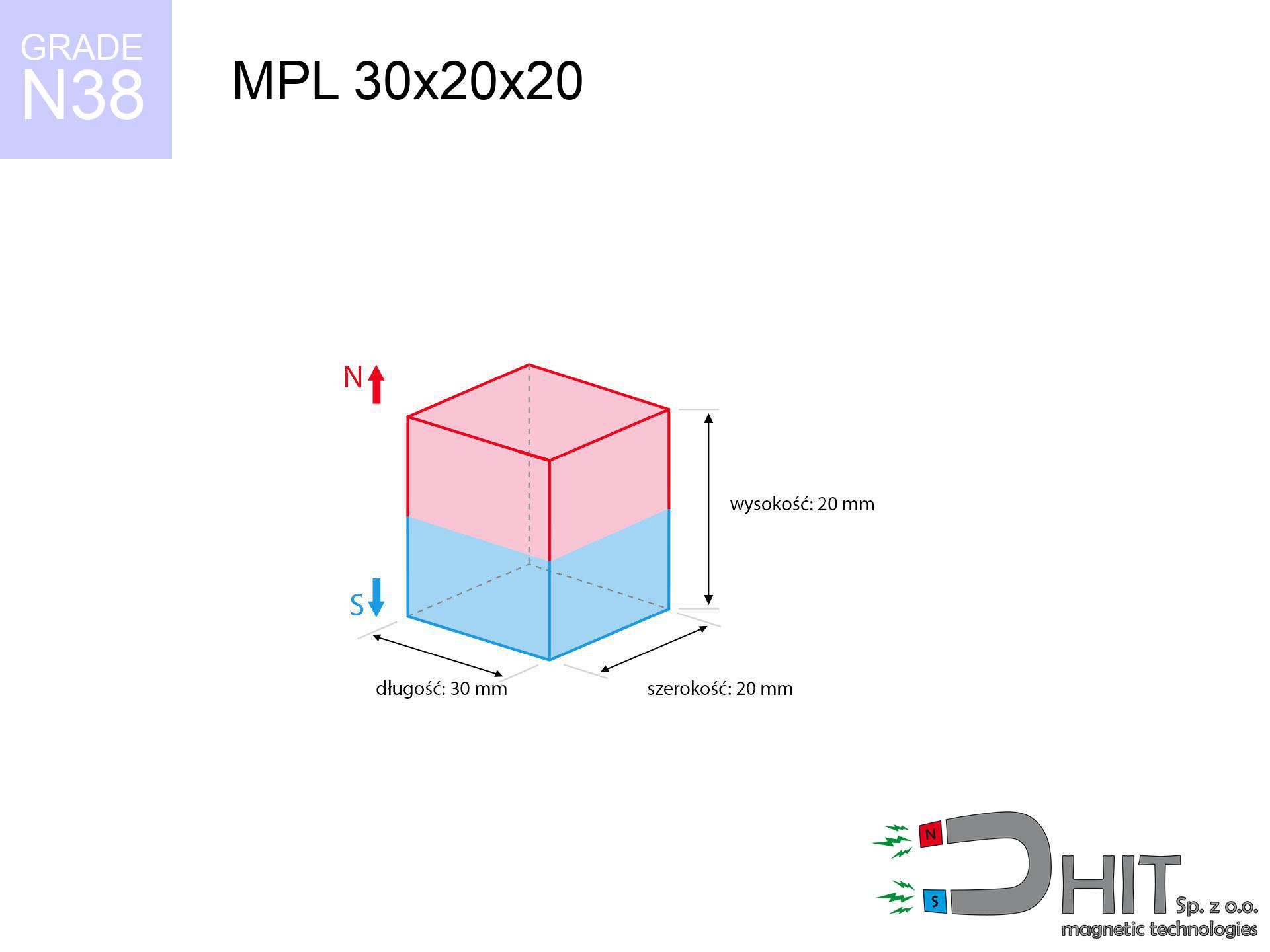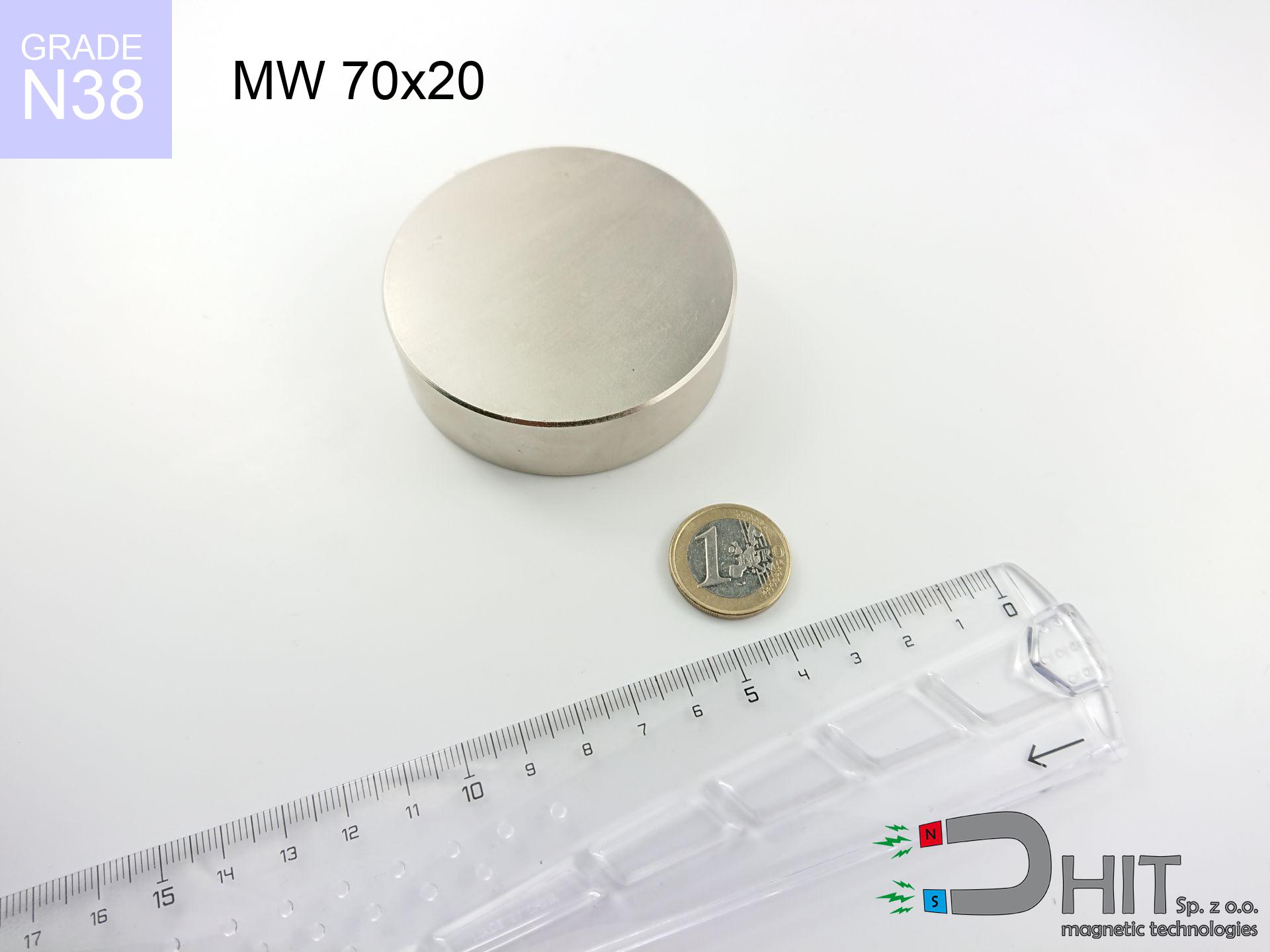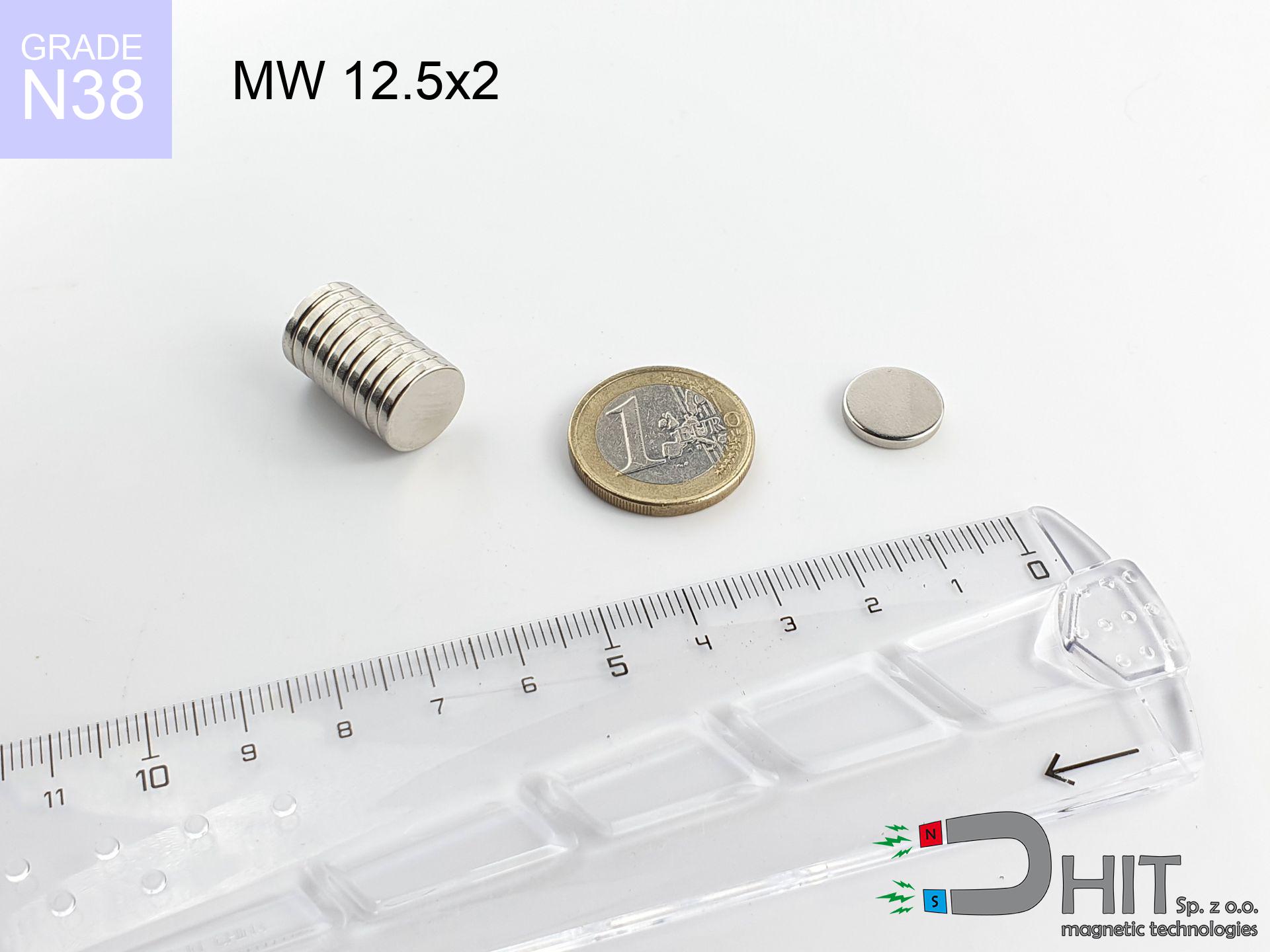MPL 30x20x20 / N38 - lamellar magnet
lamellar magnet
Catalog no 020142
GTIN: 5906301811480
length [±0,1 mm]
30 mm
Width [±0,1 mm]
20 mm
Height [±0,1 mm]
20 mm
Weight
90 g
Magnetization Direction
↑ axial
Load capacity
38.69 kg / 379.42 N
Magnetic Induction
512.53 mT
Coating
[NiCuNi] nickel
43.22 ZŁ with VAT / pcs + price for transport
35.14 ZŁ net + 23% VAT / pcs
30.14 ZŁ net was the lowest price in the last 30 days
bulk discounts:
Need more?Not sure about your choice?
Give us a call
+48 22 499 98 98
alternatively let us know through
form
the contact form page.
Weight as well as form of magnetic components can be estimated with our
force calculator.
Orders placed before 14:00 will be shipped the same business day.
MPL 30x20x20 / N38 - lamellar magnet
Magnetic properties of material N38
Physical properties of NdFeB
Shopping tips
Due to their power, flat magnets are frequently used in structures that require exceptional adhesion.
Typical temperature resistance of these magnets is 80 °C, but with larger dimensions, this value can increase.
Additionally, flat magnets usually have different coatings applied to their surfaces, e.g. nickel, gold, or chrome, for enhancing their strength.
The magnet with the designation MPL 30x20x20 / N38 i.e. a magnetic force 38.69 kg which weighs just 90 grams, making it the excellent choice for projects needing a flat magnet.
Contact surface: Due to their flat shape, flat magnets guarantee a larger contact surface with adjacent parts, which is beneficial in applications requiring a stronger magnetic connection.
Technology applications: They are often utilized in various devices, e.g. sensors, stepper motors, or speakers, where the thin and wide shape is necessary for their operation.
Mounting: Their flat shape simplifies mounting, particularly when there's a need to attach the magnet to another surface.
Design flexibility: The flat shape of the magnets permits designers a lot of flexibility in arranging them in structures, which can be more difficult with magnets of other shapes.
Stability: In some applications, the flat base of the flat magnet can offer better stability, reducing the risk of sliding or rotating. However, one should remember that the optimal shape of the magnet depends on the given use and requirements. In certain cases, other shapes, such as cylindrical or spherical, may be more appropriate.
Magnets have two main poles: north (N) and south (S), which attract each other when they are oppositely oriented. Similar poles, such as two north poles, act repelling on each other.
Due to these properties, magnets are commonly used in electrical devices, such as motors, speakers, sensors, or magnetic locks. Neodymium magnets stand out with the highest power of attraction, making them ideal for applications requiring strong magnetic fields. Moreover, the strength of a magnet depends on its size and the material it is made of.
It’s worth noting that high temperatures can weaken the magnet's effect. The Curie temperature is specific to each type of magnet, meaning that once this temperature is exceeded, the magnet stops being magnetic. Interestingly, strong magnets can interfere with the operation of devices, such as compasses, credit cards and even electronic devices sensitive to magnetic fields. Therefore, it is important to avoid placing magnets near such devices.
Advantages as well as disadvantages of neodymium magnets NdFeB.
In addition to their magnetic capacity, neodymium magnets provide the following advantages:
- They retain their magnetic properties for around ten years – the loss is just ~1% (based on simulations),
- They are very resistant to demagnetization caused by external magnetic sources,
- In other words, due to the metallic silver coating, the magnet obtains an stylish appearance,
- They have extremely strong magnetic induction on the surface of the magnet,
- They are suitable for high-temperature applications, operating effectively at 230°C+ due to advanced heat resistance and form-specific properties,
- Thanks to the flexibility in shaping and the capability to adapt to specific requirements, neodymium magnets can be created in diverse shapes and sizes, which increases their functional possibilities,
- Key role in modern technologies – they are utilized in computer drives, electric drives, healthcare devices along with high-tech tools,
- Compactness – despite their small size, they deliver powerful magnetism, making them ideal for precision applications
Disadvantages of rare earth magnets:
- They are prone to breaking when subjected to a powerful impact. If the magnets are exposed to mechanical hits, we recommend in a steel housing. The steel housing, in the form of a holder, protects the magnet from cracks and additionally increases its overall robustness,
- High temperatures may significantly reduce the holding force of neodymium magnets. Typically, above 80°C, they experience permanent decline in performance (depending on height). To prevent this, we offer heat-resistant magnets marked [AH], capable of working up to 230°C, which makes them perfect for high-temperature use,
- Due to corrosion risk in humid conditions, it is wise to use sealed magnets made of protective material for outdoor use,
- Using a cover – such as a magnetic holder – is advised due to the limitations in manufacturing fine shapes directly in the magnet,
- Health risk related to magnet particles may arise, when consumed by mistake, which is notable in the context of child safety. Moreover, small elements from these assemblies might disrupt scanning after being swallowed,
- In cases of tight budgets, neodymium magnet cost may be a barrier,
Maximum lifting force for a neodymium magnet – what affects it?
The given strength of the magnet corresponds to the optimal strength, calculated in ideal conditions, that is:
- with mild steel, used as a magnetic flux conductor
- of a thickness of at least 10 mm
- with a polished side
- with zero air gap
- under perpendicular detachment force
- at room temperature
Determinants of lifting force in real conditions
The lifting capacity of a magnet is determined by in practice the following factors, ordered from most important to least significant:
- Air gap between the magnet and the plate, because even a very small distance (e.g. 0.5 mm) can cause a drop in lifting force of up to 50%.
- Direction of applied force, because the maximum lifting capacity is achieved under perpendicular application. The force required to slide the magnet along the plate is usually several times lower.
- Thickness of the plate, as a plate that is too thin causes part of the magnetic flux not to be used and to remain wasted in the air.
- Material of the plate, because higher carbon content lowers holding force, while higher iron content increases it. The best choice is steel with high magnetic permeability and high saturation induction.
- Surface of the plate, because the more smooth and polished it is, the better the contact and consequently the greater the magnetic saturation.
- Operating temperature, since all permanent magnets have a negative temperature coefficient. This means that at high temperatures they are weaker, while at sub-zero temperatures they become slightly stronger.
* Lifting capacity testing was carried out on plates with a smooth surface of suitable thickness, under a perpendicular pulling force, whereas under attempts to slide the magnet the load capacity is reduced by as much as 5 times. In addition, even a slight gap {between} the magnet and the plate reduces the lifting capacity.
Caution with Neodymium Magnets
The magnet is coated with nickel. Therefore, exercise caution if you have an allergy.
Studies clearly indicate a small percentage of people who suffer from metal allergies such as nickel. An allergic reaction often manifests as skin redness and rash. If you have a nickel allergy, try wearing gloves or avoid direct contact with nickel-plated neodymium magnets.
Neodymium magnets can attract to each other, pinch the skin, and cause significant injuries.
Magnets will crack or alternatively crumble with uncontrolled joining to each other. Remember not to move them to each other or have them firmly in hands at a distance less than 10 cm.
Magnets should not be treated as toys. Therefore, it is not recommended for youngest children to have access to them.
Neodymium magnets are not toys. You cannot allow them to become toys for children. In such a situation, surgery is necessary to remove them. In the worst case scenario, it can result in death.
Neodymium magnets are not recommended for people with pacemakers.
Neodymium magnets produce strong magnetic fields that can interfere with the operation of a heart pacemaker. Even if the magnetic field does not affect the device, it can damage its components or deactivate the entire device.
Under no circumstances should neodymium magnets be brought close to GPS and smartphones.
Neodymium magnets produce intense magnetic fields that interfere with magnetometers and compasses used in navigation, as well as internal compasses of smartphones and GPS devices.
Dust and powder from neodymium magnets are flammable.
Do not attempt to drill into neodymium magnets. Mechanical processing is also not recommended. If the magnet is crushed into fine powder or dust, it becomes highly flammable.
Keep neodymium magnets away from the wallet, computer, and TV.
Neodymium magnets produce intense magnetic fields that can damage magnetic media such as floppy disks, video tapes, HDDs, credit cards, magnetic ID cards, cassette tapes, or other devices. They can also destroy devices like video players, televisions, CRT computer monitors. Remember not to place neodymium magnets close to these electronic devices.
Neodymium magnets can demagnetize at high temperatures.
Although magnets have shown to retain their effectiveness up to 80°C or 175°F, this temperature may vary depending on the type of material, shape, and intended use of the magnet.
Neodymium magnets are the strongest magnets ever created, and their power can surprise you.
On our website, you can find information on how to use neodymium magnets. This will help you avoid injuries and prevent damage to the magnets.
Neodymium magnets are characterized by their fragility, which can cause them to crumble.
Magnets made of neodymium are extremely fragile, and by joining them in an uncontrolled manner, they will crack. Neodymium magnetic are made of metal and coated with a shiny nickel, but they are not as durable as steel. In the event of a collision between two magnets, there may be a scattering of fragments in different directions. Protecting your eyes is crucial in such a situation.
Pay attention!
In order for you to know how powerful neodymium magnets are and why they are so dangerous, read the article - Dangerous very strong neodymium magnets.









